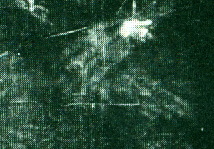SHROUD SERIES, Part 2:
THE HANDS
by Fr. Hilary Conti, O.S.B.
continued from Part
1...
The
medical doctor then pointed to the center of the picture, saying: these
are the Hands of Jesus. Notice first of all the number of fingers:
four and not five. This is because the nail, or spike, pierced not
the palm, but the wrist at the point known as the destot. At this
point a nail can be driven through easily without breaking any bones, and
it will hold firmly against the greatest  tension.
On the Shroud you may see the hole on the wrist of the left hand and with
the pointer he indicated exactly the spot. A nail fixed in the wrist
presses or lacerates the median nerve, which controls the muscular action
of the fingers. Such injury to this nerve caused the fingers to curve
slightly and stiffly, while the thumb was turned inward against the palm.
These two wounds were extremely painful because the nail had damaged the
median nerve which is a sensatory nerve. It is surprising that our
Lord on the cross never fainted.
tension.
On the Shroud you may see the hole on the wrist of the left hand and with
the pointer he indicated exactly the spot. A nail fixed in the wrist
presses or lacerates the median nerve, which controls the muscular action
of the fingers. Such injury to this nerve caused the fingers to curve
slightly and stiffly, while the thumb was turned inward against the palm.
These two wounds were extremely painful because the nail had damaged the
median nerve which is a sensatory nerve. It is surprising that our
Lord on the cross never fainted.
“Do
not be surprised to hear”, the doctor said, “...on the Shroud we see symptoms
indicating that Jesus died of asphyxiation. As you yourselves may
see, the rib cage of Jesus is expanded and the epigastric hollow is contracted.
These are symptoms of death by asphyxiation and tetany. For us medical
doctors, this is no surprise. Our Lord had been suspended on the
cross by two nails in the wrists. His arms were thus stretched above
His head. The muscles of the arms became extremely tired, thus developing
spasms, then cramps, eventually tetany. In other words, Jesus on
the cross had what we call convulsions; His whole nervous system went out
of order because of the spasms and as a result he was able to breathe in
but not out. That is why he died of suffocation.”
One
person in the audience raised his hand to ask about the authenticity.
After
a pause, the doctor answered, “I hope you are not asking if this is a painting
or not. If that is the question, I resent it. I have been studying
x-ray photographs for many years and by now I should know the difference
between a photograph of a person and a painting. I suppose your question
is, ‘who is this man?’ Is there any evidence that he is the man crucified
by Pontius Pilate? Yes, that is a good question. The execution
of this man by crucifixion is in perfect harmony with Gospels, in every
minor detail, such that lawyers would say, we have here a five fingerprint
proof. Besides, there are three details very helpful in identifying
this man as Christ:

1. The crown of thorns, which
was never used for other persons;
2. The person was definitely
dead as we see the rigor mortis, and there are no signs of bodily decomposition
or corruption;
3. The fact that the family
or friends preserved the burial linen as a remembrance even though on it
you may see signs of his crucifixion, the most painful and humiliating
execution. That is a sign that this man was a very important person
before death as well as after death.
Such a profession of faith made by an outstanding man of science in public,
with a decisive expression on his face, it shook me up. I wished
that newspaper reporters had been there, I wished that a public address
system had been there to pick up his words and broadcast them outside,
in the city, on the television networks, and let the world know that scientists
have finally come to believe in Jesus Christ, crucified, the Son of the
living God, and that religion is not the opium of simple people.
 tension.
On the Shroud you may see the hole on the wrist of the left hand and with
the pointer he indicated exactly the spot. A nail fixed in the wrist
presses or lacerates the median nerve, which controls the muscular action
of the fingers. Such injury to this nerve caused the fingers to curve
slightly and stiffly, while the thumb was turned inward against the palm.
These two wounds were extremely painful because the nail had damaged the
median nerve which is a sensatory nerve. It is surprising that our
Lord on the cross never fainted.
tension.
On the Shroud you may see the hole on the wrist of the left hand and with
the pointer he indicated exactly the spot. A nail fixed in the wrist
presses or lacerates the median nerve, which controls the muscular action
of the fingers. Such injury to this nerve caused the fingers to curve
slightly and stiffly, while the thumb was turned inward against the palm.
These two wounds were extremely painful because the nail had damaged the
median nerve which is a sensatory nerve. It is surprising that our
Lord on the cross never fainted.
